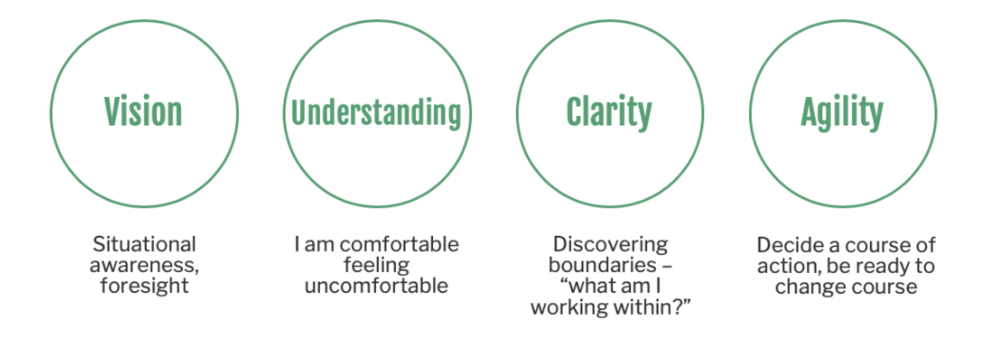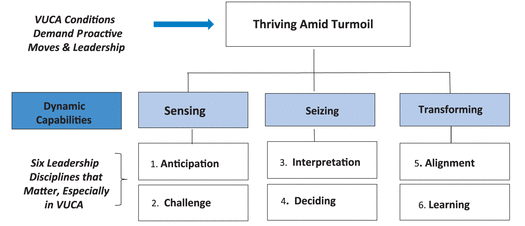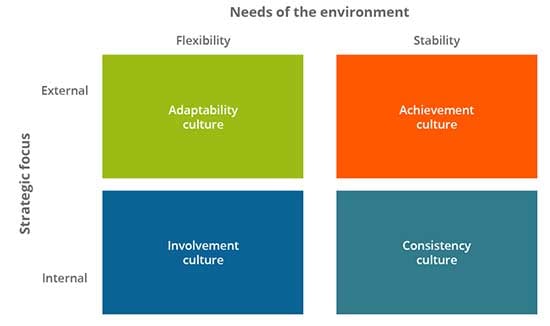5 min read
Being a Manager Leader in the VUCA World
12 May 2022
 Trasha Sharma
Trasha Sharma
Introduction
Do you ever feel that the world is speeding up? Does the short-term seem too long?
The world we live in is Volatile, Uncertain, Complex and Ambiguous, i.e., VUCA. This presents huge challenges to leaders – in a VUCA world, they can never have full control of their environment and must be prepared to deal with constant evolution and change.
I chose to take this course ‘Being a Manager Leader in the VUCA World’ — being offered by Charles Strut University — to understand the major challenges faced by VUCA managers in an environment where the distinction between managers and leaders is blurred. It helped me understand the types of leadership skills and approaches that are required for effective management in this ever-changing environment and to improve business outcomes in a chaotic world.

An Overview of VUCA. Source: Flat World Business
The great big challenges in this world are:
- Globalisation: Global reach of companies carries several challenges, including the prospect of much greater competition.
- Disruptive innovation: The speed at which disruptive business models are built by leveraging the fusion of digital and physical capabilities and experiences, is disruptive.
- Entrepreneurship: The drive toward innovation, disruptive or otherwise, is complemented by the rise of the entrepreneurial manager and entrepreneurial culture. Management is no longer limited to coordinating business as usual.
- Artificial intelligence: Advanced robotics, machine learning and artificial intelligence are fundamentally altering business models and industries. Often, these changes are not only alien to businesses, they are also taking place at an unprecedented speed.
So how do we equip and transform the next generation of leaders with the relevant skills and competencies to meet these challenges?
To survive and thrive in today’s world, we need Vision, Understanding, Clarity and Agility – the counterweight to VUCA, called “VUCA Prime”.

The VUCA Manager Leader: Difference between Management and Leadership
A simplistic view of the difference between leaders and managers is that leaders inspire and motivate others to follow and commit to their vision. Managers, on the other hand, are the ones who allocate work and resources to team members to achieve outputs.
Increasingly, in the new millennium workplace, people want to understand where the organisation is going and their importance in its plans. They want to believe that the values of the company are aligned with their personal value system. Due to this shift in the approach to work, the differences between a manager and leader are disappearing day by day.
The skills associated with human interactions have become increasingly important. These include trust, communication, collaboration, adaptability, empathy, self-awareness, a strong moral code and a commitment to ecological and social sustainability. The more recent theories of leadership more aligned to these needs are:
- Servant leadership: Servant leaders give away power, ideas, recognition, credit etc. They place value in trust and people, encourage trust, share power, recognise and support others; which is highly important in a VUCA world, where collaboration, innovation, creativity and varying individual strengths need to be harnessed collectively to achieve transformational outcomes.
- e-Leadership: Strong e-leaders tend to be open-minded, solution-focussed and have strong communication, coaching and relationship skills. They use technology to enhance and foster human interactions instead of trying to replace them. Effective e-leaders must be strong communicators who set clear goals, expectations and timelines to improve coordination and ensure delivery of work.
- Eco-Leadership: Eco leaders view the organisation as part of an ecological and social ‘ecosystem’. They take into consideration the social, economic and environmental impacts that business leadership decisions have on people and the surrounding environment.
- Moral Leadership: Moral leaders recognise the importance of values in maintaining a healthy organisational culture. This is why, for moral leaders, upholding company values is a priority while making decisions and approaching the people they work with. They understand that values play a major role in shaping our behaviour and how we treat people we work with.
Strategy Formulation in the VUCA World
Until a few years ago, the strategy making process in an organisation was pretty clear. There were three levels of strategy: corporate, business and operational, and the work in management practice was aligned among these three levels.
- Corporate-level strategy targeted all of the business units in a large, conglomerate organisations such as BHP or Westpac Banking Corporation.
- Business-level strategy focused on each business unit within the organisation.
- Operational strategy targeted specific activities within a business unit – day to day operations.
The fundamental problem with the traditional approach to strategic management, however, is that it is better suited to predictable, stable environments and not the today’s VUCA world.
One recent adaptation of the traditional approach to strategy formulation is the “always-on” strategy, which addressess unexpected changes in the strategic environment.

Annual vs Always-on Strategy. Source: Being a Manager Leader in a VUCA World Course
Essential Skills for Strategic Leadership
Sensing, seizing and transforming are the most essential skills for strategic leadership, according to Paul J. H. Schoemaker, Steve Krupp and Samantha Howland.

Leadership Disciplines in VUCA. Source: Being a Manager Leader in a VUCA World Course
- Anticipate: Foresee challenges, look for weak signals, seek feedback from all stakeholders (refer to eco-leadership approaches).
- Challenge: Question the situation, view the issue from multiple lense, invite different perspectives and apply the five Whys. (Learn more about the five Whys here).
- Interpret: Look at the data and figure out hidden or underlying trends and issues.
- Decide: View alternate options, divide big decisions into parts to examine all aspects, involve others, consider pilots and make staged commitments.
- Align: Communicate early and often, identify key influencers, monitor stakeholder reactions and reward alignment.
- Learn: Failures are opportunities to learn so foster a culture of innovation, not criticism.
The Importance of Culture & People Management
With globalisation, more organisations are expanding operations with some establishing offices in multiple locations across the globe.
The culture of an organisation defines ‘the way things are done around here’. It encloses shared values, beliefs, understandings, norms and behaviours and makes a huge impact on:
- How decisions are made.
- Who makes them and how quickly.
- Whether the organisation has an appetite for risk.
- Whether failure is accepted or frowned upon.
- How customers are viewed and valued.
- Which stakeholders are prioritised by an organisation.

Today’s VUCA Workplace. Source: Being a Manager Leader in a VUCA World Course
Different types of cultures are more suited to different environments. It is up to managers to decide the kind of culture they want to promote in their organisation that would suit the nature of work.
- An adaptive culture: Useful for a high-risk environment that requires a fast response. In this culture, employees have the autonomy to make decisions in order to serve highly valued customers. Creativity, innovation and risk-taking are rewarded.
- An achievement culture: Suits more stable environments where customers are specific. Competitiveness, aggressiveness, initiative, and the drive to work hard and win are characteristics of this culture. High performance is rewarded.
- An involvement culture: Places a high value on employee participation, cooperation and support.
- A consistent culture: Has an internal focus and operates in an increasingly rare stable environment. Rationality, rules, procedures, and order are valued.

Impact of Culture on the Work Environment. Source: Being a Manager Leader in a VUCA World Course
How to Gain a Better Understanding of Your People
To understand how your organisation is performing in meeting employee expectations, ask these questions:
- Do I know what is expected of me at work?
- Do I have the materials and equipment I need in order to do my work well?
- Do I have the opportunity to do what I do best every day?
- Have I received recognition or praise for doing good work in the past 7 days?
- Does my supervisor or others at work care about me as a person?
- Does my workplace encourage my development?
- Do my opinions matter at work?
- Does the mission or purpose of my company make me feel that my job is important?
- Are my co-workers committed to doing quality work?
- Do I have a best friend at work?
- In the past six months, has someone talked to me about my progress?
- Have I had opportunities to grow and learn over the past year?
You should also analyse what motivates them using the below motivational mapping technique.

Motivational Mapping Technique to Analyse what Motivates your Team. Source: Author
Conclusion
“Leadership is a journey which has no destination.”
This is one of the major takeaways of the course. To be an effective manager leader in the VUCA world we need to invest in ourselves. We need to continually engage in self-reflection, learning and improvement to stay competitive, relevant and employable. Completing this course is a great initiative in self-development and will help with learning soft skills that are required in order to become and stay a successful leader in the VUCA world.


